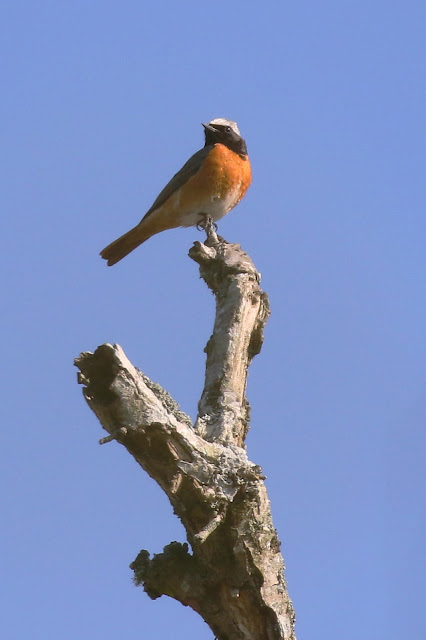The Easter Bank Holiday weekend provides a unique opportunity for the lover of rare birds: an uninterrupted four day window at a promising time of year to stress out with the added attraction of heavy traffic. Whilst I had idly clocked news of a Rufous-tailed Rock Thrush on the Isles of Scilly, I hadn't really considered going to see it until, not for the first time this decade, a text message from David Bradnum gave me the kick in the rear I needed to start thinking about it.
 |
| Rock Thrush, Bread and Cheese Cove, St Martin's |
 |
| A red, white and blue riot of colour |
Neither of us fancied day-tripping it, preferring an overnight stay to make the most of the islands and provide a second shot at seeing the bird if we were unsuccessful on the day of our arrival. Whilst not impossibly complicated, the logistics weren't straightforward: tickets for Scillonian III would be simple enough to procure, accommodation on Scilly during one of the busiest weekends of the year less so. But after just a few phone calls (Scilly's tourist industry has yet to get the hang of on-line booking), we managed to find a reasonably priced twin room.
 |
| The rufous tail seen clearly in flight |
 |
| Note the white patch on the back of the Rock Thrush |
That just left the small matter of getting from St Mary's to Daymark on St Martin's, where the Rock Thrush had spent the previous week. We were due to disembark the Scillonian at 1200 and an inter-island launch was due to leave for St Martin's at 1230, so that shouldn't be a problem either. All that remained was to secure permission to go from respective loved ones, and with that done, Operation Daymark was good to go.
 |
| Song Thrush: commoner than Rock Thrush on Scilly, and more confiding too |
 |
| Daymark on St Martin's viewed from St Mary's |
David arrived in Dorset from Essex for a few hours kip at our place and an 0400 start on Good Friday saw us arriving in Penzance in plenty of time to make the Scillonian. After possibly the smoothest crossing I have experienced, we made good time and shortly after midday were at the front of the queue on the quay for the boat to St Martin's. The latter island was hosting a music festival and we watched in dismay as suitcases, guitars and violin cases were unloaded carefully, and therefore excruciatingly slowly, from the Scillonian to a first, second, then third waiting boat - and all by hand. 1230 came and went, and when what appeared to be a drumkit appeared, it was too much for one enterprising birder who chartered a jetboat and offered us two seats on it. Once he had retrieved the hand we had bitten off, we were on our way.
 |
| Greenshank: the only wader present at Lower Moors on St Mary's |
 |
| Wheatear: one of several on Peninnis |
The advantage of the jetboat was not just the ability to jump the queue, but also to reduce the travel time and provide another half an hour on St Martin's before we needed to make the return journey. Unfortunately, the low tide meant that the disembarkation point was at the opposite end of the island to the cove where the bird was being seen.
 |
| White Wagtail on the quay at Hugh Town |
 |
| Always a smart bird to see |
The best part of half an hour later we arrived breathless and perspiring to catch up with more sprightly souls who had set a blistering pace across the island. Fortunately for all of us, islander Will Scott had the bird staked out in Bread and Cheese cove and shortly after arriving we were enjoying good views as the bird fed on the heather clad slopes and rocks around the cove.
 |
| Scilly Wren |
 |
| This bird was singing on St Mary's |
A few late-comers who had not joined us on the jetboat arrived even more breathless and sweaty, but they too enjoyed views of the bird before it headed to the other side of the cove. The walk back to the boat was altogether more relaxed and there was even time for a bit of birding back on St Mary's after the all the yomping around St Martin's.
 |
| Rock Pipit at Porthloo |
 |
| Another songster |
After the excitement of Good Friday, Saturday was uneventful but enjoyable on St Mary's. A few dozen Manx Shearwater and a single Common Dolphin provided interest on the way home. A fairly epic twitch then, with thanks to David for driving and providing the motivation to make the effort.
 |
| Manx Shearwater from Scillonian III |
 |
| Rock Thrush - ordinarily at this time of year this bird would be breeding in southern European mountain range above the 1500m line - incredible to see it on a Scilly beach |
























































